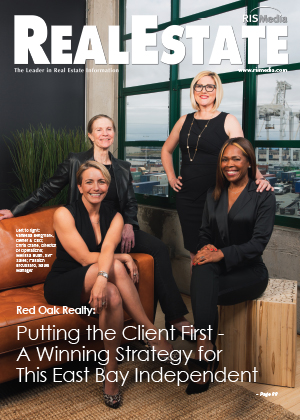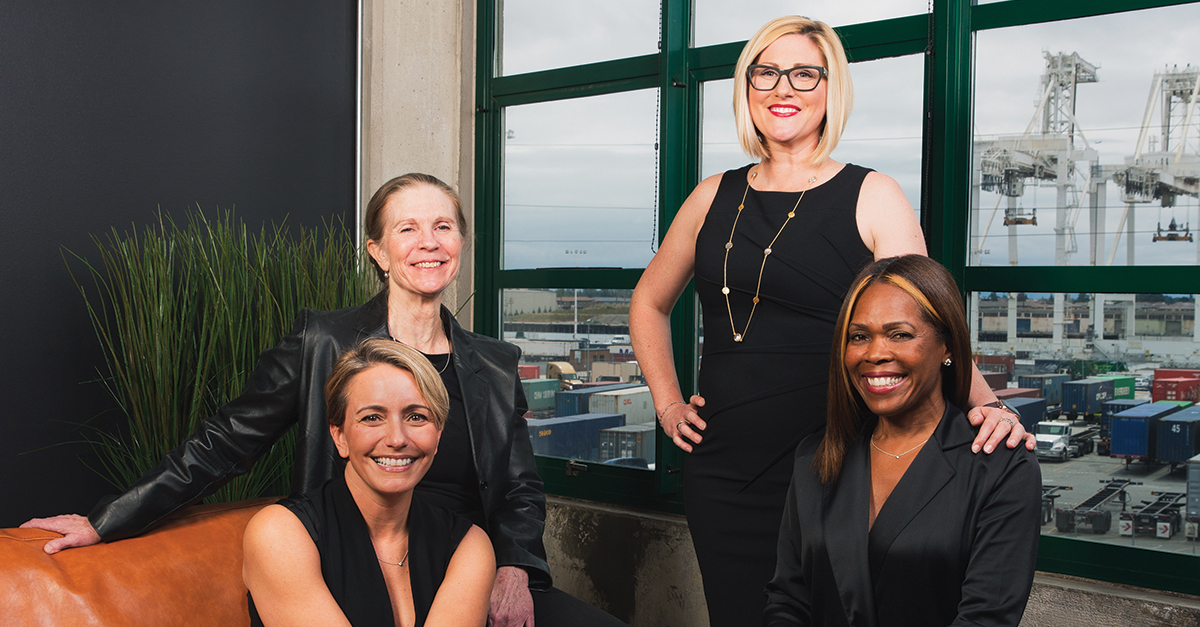(L to R) Vanessa Bergmark, Owner & CEO; Chris Crane, Director of Operations; Melissa Bush, SVP Sales; Passion Broussard, Sales Manager
 For Vanessa Bergmark, growth was never about bigger, but rather, better. As the owner and CEO of the San Francisco Bay Area’s Red Oak Realty, Bergmark has led the company, which was founded in 1976, from 12th in marketshare to closing in on second without the typical brokerage formula of increasing offices and agent count. Instead, Bergmark turned her focus squarely on the consumer. “Having more agents isn’t what’s best for the consumer,” she explains. “Having agents that have resources that can protect and support the consumer is what matters.” Fresh off a rebranding that’s positioning the company for the future, Bergmark shares her strategy for helping homebuyers and sellers navigate the exceptionally lucrative yet challenging Bay Area real estate market in this exclusive interview.
For Vanessa Bergmark, growth was never about bigger, but rather, better. As the owner and CEO of the San Francisco Bay Area’s Red Oak Realty, Bergmark has led the company, which was founded in 1976, from 12th in marketshare to closing in on second without the typical brokerage formula of increasing offices and agent count. Instead, Bergmark turned her focus squarely on the consumer. “Having more agents isn’t what’s best for the consumer,” she explains. “Having agents that have resources that can protect and support the consumer is what matters.” Fresh off a rebranding that’s positioning the company for the future, Bergmark shares her strategy for helping homebuyers and sellers navigate the exceptionally lucrative yet challenging Bay Area real estate market in this exclusive interview.
Maria Patterson: Red Oak Realty has a rich history. Tell us a bit about it.
Vanessa Bergmark: The four founders started the company in 1976 in a garage in Albany, Calif.—just like Apple! Like a lot of companies in the ’70s, we were formed by a group of dissatisfied agents who didn’t feel they were getting the resources they needed, so they went out on their own and started Red Oak. The company has had great retention ever since. Many of the people who were with the company back then are still here today or just recently retired.
MP: When did you come on board?
VB: I joined the firm at the beginning of the downturn in 2007, when REOs were the norm and technology had moved very quickly into the real estate space. I had been running a large franchise and had just adopted my first child. The guys at Red Oak tracked me down and I went from running an office of 200 people to 20 people. Everyone said I was taking a step backwards, but to have the possibility to be home at 6:00 p.m. and not be on a plane all the time…I jumped at the opportunity.
After a year and a half, I took over both the Oakland and Berkeley offices as the general manager, and in 2010, purchased the company from the original four owners. At the time, a lot of people thought I was nuts. This was during the worst downturn in economic history, and, at that point, I had a two-year-old and a six-month-old.
MP: Interesting timing, given the start of the recession. How did you help the firm through it?
VB: I learned about REOs and short sales, got our agents into coaching and training, and moved everyone toward technology. We got off desktops and onto laptops. We moved into paperless transactions and advertising digitally and upping the ante with photography. I changed the operations of the company from a more traditional approach to one that was a bit more tech-savvy and strategic.
MP: So, where does the firm stand today in terms of size and marketshare?
VB: We have two offices and 116 agents and staff combined. We were 12th in marketshare when I bought the company, and now we’re hugging second place.

MP: How did you achieve such impressive growth without acquiring offices and agents?
VB: We’re not a huge brokerage and our trajectory is not that of most traditional brokerages. We did it not by recruiting a massive amount of agents—we’re at just 100 agents. Rather than putting our efforts into recruiting a lot of agents, we focused on staffing. We hired a great marketing director, beefed up our transaction department and brought on superior legal support. We hired smart agents and focused on their needs. We upped all of our resources so that we could provide more support to agents in order to improve the client experience. We grew our marketing team with people who understood digital marketing and social media and all the things you can do today to advertise a property. For every property we list, there’s a process baked in to support our clients at a very high level.
MP: Why is this strategy of investing within, as opposed to spreading out, particularly important in your area?
VB: In the Bay Area, you might have to write 6-10 offers to get one into contract; properties move within 14 days. Much of the work is done on the front end by staff and agents before a listing even goes public. It’s like a production for a movie—and the seller is the one who benefits. I believed that having multiple offices spread out in multiple territories with multiple agents and multiple managers would be diluting the experience—what we wanted to offer was a distilled experience. So we grew our local market knowledge instead. And it’s worked. We were at $250 million in sales when I bought the company and we’re just under $1 billion today.
MP: So, how does your strategy of focusing on the agents you have rather than recruiting more agents translate to better service for the consumer…and increased profitability for your firm?
VB: Having more agents isn’t what’s best for the consumer. Having agents that have resources that can protect and support the consumer is what matters. Those resources don’t usually come in the form of another agent; they come in the form of a well-trained, sophisticated support staff on the back end—people who can do all the research and admin work so that the agent can focus on what they do best, which is knowing the market, getting the house prepared and successfully negotiating the transaction. Our model is to run the firm like a serious business. By doing so, our per-person production increased by 30-40 percent. The market changes like the tide; if you’re not full-time servicing several transactions a month, the consumer you’re working for won’t get the best service. Why bring in more agents who won’t do as many transactions per year? Why not support the ones you have instead?

MP: How would you describe your market? What are the greatest challenges?
VB: We’re in the technology hub of the country, so our clientele demands that you’re technologically up to speed. They want to know that you know what you’re talking about when it comes to marketing a house and financing. Our clients are incredibly educated—we’re dealing with everyone from CEOs of tech companies to savvy millennials, and the way they communicate and the speed in which we have to respond is critical. When you’re moving properties within 14 days, marketing, speed and accuracy are of the utmost importance.
MP: How are you best serving the needs of your clientele?
VB: A lot of documents go into the contract here—our agents and staff have to know a lot about disclosures, condition and local ordinances. Rather than constantly outsourcing it, we looked at how the company can internally support the agent and the client by taking this part of the job over.
As opposed to being part of a franchise, we’re deeply ingrained in a specific community. Berkeley, Calif., is unlike anywhere else in the country. There’s a high income and it’s an expensive place to live. It’s also still counterculture and doesn’t respond to elite marketing. If you try to go glitzy to appeal to the 1 percent, it works against you. So the question we ask is, “What am I doing today that will help my buyer and seller?” What am I doing to train and prepare my agents to take care of that person? Will having a lot of inexperienced agents help that consumer? Probably not. We’re hyper-focused on what our sellers need and getting their property exposed and sold.

MP: It sounds like you really take a consultative approach with every client…
VB: One of the most important things we do is educate the consumer. It’s so easy to get frustrated in this market. Educating them on what they can afford and showing them the data so that they don’t end up bidding against themselves is critical. We also educate them on financing. We can’t make the low-inventory piece go away; what we can do is help them get started within this ecosystem and not put their home-buying plans on hold for the next six years. We let people know, “Here are the tools you have; don’t go to this neighborhood—we know you love it, but this is what you can spend, so let us introduce you to this alternative where your buying power might be stronger.” From the seller’s perspective, we advise them on many things, such as how much they should put into the house to get the right return.
MP: Tell us about the typical process of working with a seller.
VB: When we first meet with someone, we really hone in on the hyperlocal statistics. Agents are well versed on market data and have access to yearly, quarterly and monthly statistics on every neighborhood that affects us. We take it down to the microscopic level and break it down by house type, by certain features that have high demand, and analyze the impact of that for sellers. That’s what we do on the front end prior to marketing. Then it’s about positioning the property for maximum return. You have to market in the portals and in the local community by word of mouth. Should there be video? A floor plan? How involved does the seller want to get in prep, interior design and landscaping? A lot of buyers don’t have time to do a renovation or put in a garden, so we often provide referrals for that. Then we focus on the best ways to market, set bid dates and create demand on those dates. All of this is done weeks, if not months, in advance by the agent. This is all very thoughtfully prepared in advance in a very methodical way.
MP: Your market is very competitive. How are you setting the company apart?
VB: We just rebranded the company. We looked at how our colors and logo play in the digital world across social media and all the digital portals, as well as print. We needed to make sure we wouldn’t get lost in the volume—that we would stand out online, in a magazine or when you’re simply driving by. We needed to make sure people would pay attention. We wanted to get both higher marketshare and consumer mindshare.
MP: How do you stay innovative in terms of marketing?
VB: I’m always very cautious about saying what the next big thing is, such as video, which can work against a property if it’s used incorrectly. It’s our job to make the property look as best as possible, then price it competitively to the right demographic. On Facebook, you can do a lot of targeted marketing.
We also hired a PR company out of LA, Lion & Orb. Anytime we get a listing, we snap photos and get the story to our PR team who then crafts a great narrative and pitches it out to publications such as Dwell, the Wall Street Journal, Curbed, etc. That’s a huge piece of our marketing with massive reach for the property and a huge benefit to our sellers.
MP: What’s on deck for the future of the firm?
VB: The firm’s focus will be on using our rebranding to have a more powerful national and local reach. We’re looking at growing our marketing team and adding services that will benefit clients. Right now, we’re all about how we serve our clients, not just in one transaction, but during the course of the homeownership experience. It’s all about learning how to stay relevant to your customer and giving them what they need as a busy homeowner. We want to take care of them on an abundant level, not only as a buyer and seller, but as a homeowner, too.
For more information, please visit www.redoakrealty.com.
 Maria Patterson is RISMedia’s executive editor. Email her your real estate news ideas at maria@rismedia.com. For the latest real estate news and trends, bookmark RISMedia.com.
Maria Patterson is RISMedia’s executive editor. Email her your real estate news ideas at maria@rismedia.com. For the latest real estate news and trends, bookmark RISMedia.com.












